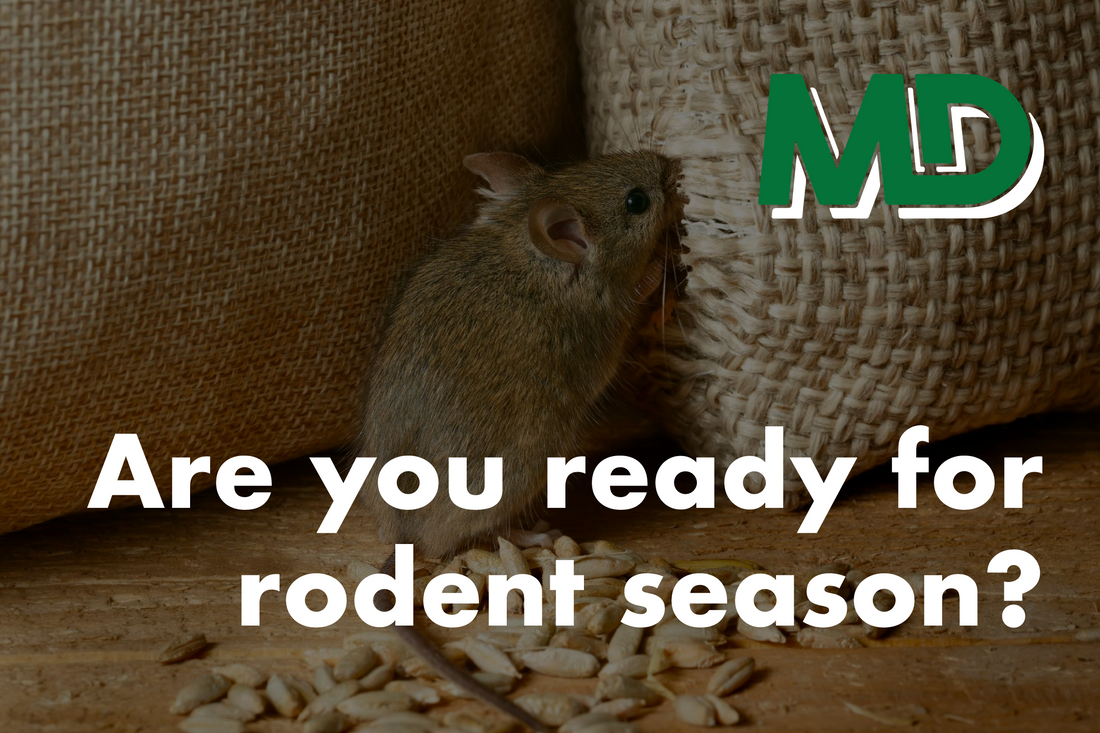
Share
When temperatures drop, rodents move indoors in search of food, warmth and shelter. Controlling rodents is vital to prevent disease transmission, food loss and contamination and structural damage, and is essential to meet farm assurance standards.

Effective action against rodents helps to protect crop yields and livestock from disease and cross-contamination. It is also vital to maintain a safe working environment for farm staff, protect nearby residents, and ensure food safety standards are met.
In addition, following best practice with rodent control ensures compliance with government acts, regulation, and farm audits. For example, under the Clean Neighbourhoods and Environment Act, farmers and waste sites must keep fly and rodent infestations under control otherwise they could be fined up to £50,000**.
1. MONITOR RODENT ACTIVITY REGULARLY
Checking for rodent activity all year round is key to keeping the risk of infestations low. Carry out a brief inspection every week to check for signs of activity. Look out for rat burrows under buildings, loop smears on beams or rafters, rat holes in dirt banks, damaged doors, holes or entry points, runs on the ground between potential feeding areas, droppings in ventilation ducts and next to food, equipment stores, and other areas around the farm.
Monitoring rodents in this way is very important to comply with the CRRU code of rodent control best practice as well as complying with farm-assured schemes such as Red Tractor.
2. USE RODENTICIDES EFFECTIVELY TO CONTROL RODENT INFESTATIONS
Rodenticides such as the Downland Ratta range are the most successful way to control rodent infestations when they occur. For farmers looking to use rodenticides to manage their rodent populations, there are a few points to consider:
- Since 2018, farmers looking to purchase over 300g of block or 150g of wheat-based rodenticide must complete training in responsible rodenticide use. The new European rodenticide regulations, which came into effect on 1 March 2018, are designed to ensure that such products are used correctly, in ways which minimise their exposure to wildlife and other non-target species. The sale and use of professional-strength rodenticides are limited to named individuals who hold a certificate which is approved by the Campaign for Responsible Rodenticide Use (CRRU) or who work for a farming business which is a member of a CRRU approved Farm-Assured Scheme. Evidence of this is required when purchasing rodenticides.
- Baiting in the correct locations is essential to control rodents effectively. When you have found an infestation, use rodenticides in tamper-resistant bait stations, such as BORA or BETA stations, placed in key areas across the farm; around buildings, drains, sewers, and feed stores. Always follow the back-label instructions on what rodenticides may be used where.
- Choose the right formulation for your needs. Rodenticides come in cut wheat, wholegrain, wax blocks, and edible pastes and range from Difenacoum multi-feed actives up to single feed Brodifacoum ones. This provides an excellent choice of baits when deciding how to control a rodent infestation.
- For example, bait, containing Difenacoum, is often used around buildings housing pigs instead of other actives. Whereas a single feed poison containing Brodifacoum is designed to solve the toughest rat and mouse infestations., a lethal dose of Brodifacoum works within hours.
- Resistance management should be on the mind of every farmer looking to control rat and mouse infestations over the long-term. To prevent resistance build-up towards a specific bait and keep rodents interested in eating them, change the active ingredient of your rodenticide periodically.
 3. LIMIT POTENTIAL FOOD SOURCES
3. LIMIT POTENTIAL FOOD SOURCES
Any sources of food on farms should be kept clean whenever possible. These, when left as spillage lying around, can allow the rodent to feed away from the rodenticide and may cause efforts to control infestations to be ineffective.
However, around livestock troughs and feeding areas, this is much more difficult. To reduce risk carry out regular checks and monitoring to identify rodent activity sooner
4. KEEP THE FARM TIDY
Rubbish and waste (whether organic or man-made) around a farm are an ideal place for rodents to shelter and remain out of sight from both farmers and natural predators. Maintaining a tidy farm is an essential part of rodent control. Often sites around chicken housing, calf rearing pens and grain silos can be littered with old equipment and containers. Removing these will go a long way in keeping rodents away from the farm.
5. PROOF BUILDINGS
Proofing buildings and other areas around the farm from rodents is essential for three reasons.
- It prevents damage to expensive or critical machinery in locations where rats may gnaw through cables or create holes and damage.
- It will make access to food stores and other key areas more challenging for the rodents. This prevents disease spread risk to animals and loss of yield with crop stores.
- It hampers rodent efforts to find a suitable nesting areas and shelter near a food source.
To proof areas, use wire mesh and fill any holes on the ground, protect cabling with an anti-rodent spray and physical barriers such as metal baffles and casings, and sure up drainage pipes.
To stop and control an infestation on your farm, it is essential to follow best practice in rodent control protecting your business, safety, and the environment. Rodenticides are an effective method of controlling rats and mice and should be used only while considering CRRU guidelines. Other forms of rodent control methods such as trapping are available.
Fortunately, with good planning and the right products, damaging infestations can be prevented. For more information on how to protect your farm from infestations this Autumn call in and see us at Meirion Davies.
